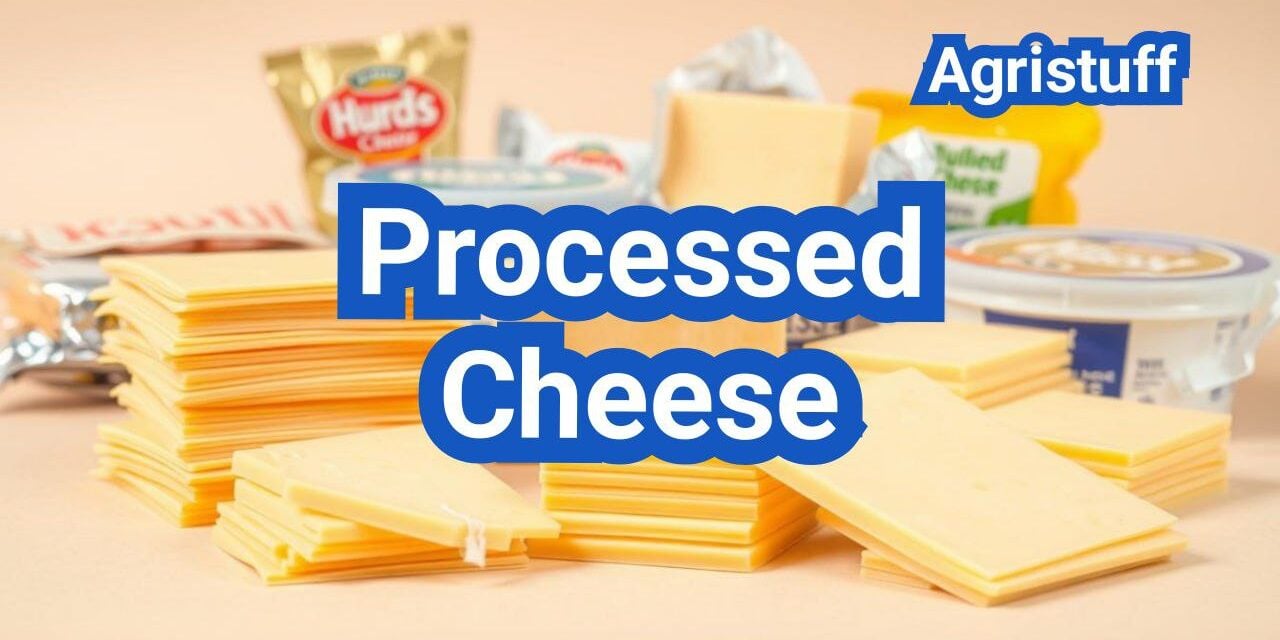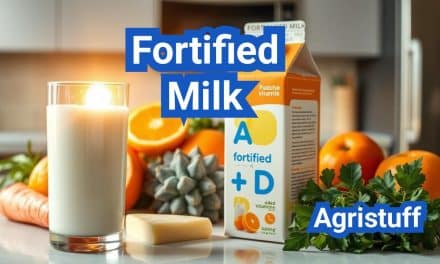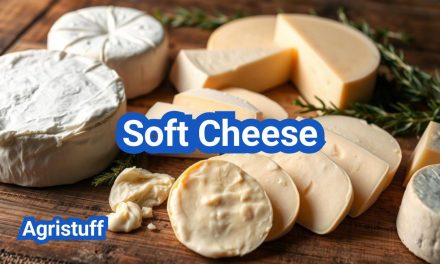A popular dairy product, processed cheese is made by blending natural cheese with emulsifying agents and other ingredients. This combination gives it several technical advantages, including a longer shelf life and resistance to separation when cooked.
The history of processed cheese dates back to the early 20th century when it was first developed. Since then, it has become a staple in many cuisines around the world, particularly in the United States.
There are various types of processed cheese products available, catering to different tastes and culinary needs.
Key Takeaways
- Definition and composition of processed cheese
- Historical background of processed cheese
- Variety of processed cheese types
- Advantages of processed cheese over natural cheese
- Common uses of processed cheese in cooking
What Is Processed Cheese?
Understanding processed cheese requires a look into its definition, differences from natural cheese, and the regulatory standards that govern its production. Processed cheese is a product that has gained widespread acceptance globally due to its versatility and convenience.
Definition and Meaning
Processed cheese is defined by the FDA under the U.S. Code of Federal Regulations Title 21, Section 133. It encompasses products like pasteurized process cheese and processed cheese food, each with specific requirements regarding their composition and labeling. These products are made by blending natural cheese with other ingredients and then processing the mixture to create a uniform product.
The definition of processed cheese highlights its distinction from natural cheese, emphasizing the processing steps involved in its manufacture. This processing can include heating, emulsifying, and adding preservatives to enhance shelf life and melting properties.
Processed Cheese vs. Natural Cheese
The primary difference between processed cheese and natural cheese lies in their production processes. Natural cheese is made directly from milk (or a mixture of milks) through fermentation and coagulation, whereas processed cheese is manufactured by altering natural cheese through various treatments.
Processed cheese often contains additional ingredients such as emulsifying salts, coloring agents, and preservatives, which are not typically found in natural cheese. These additives contribute to the extended shelf life and improved melting characteristics of processed cheese.
Standards of Identity
The standards of identity for processed cheese products are crucial for ensuring consistency and quality. In the United States, these standards are outlined by the FDA and include specifications for the composition of products like pasteurized process cheese and processed cheese food.
For instance, pasteurized process cheese must contain at least 51% natural cheese by weight, while processed cheese food must have at least 23% natural cheese. These standards help in maintaining the integrity of processed cheese products and provide consumers with clear expectations about what they are purchasing.
The History and Evolution of Processed Cheese
From its humble beginnings in Switzerland to its widespread popularity worldwide, processed cheese has evolved significantly. The story of processed cheese is a tale of innovation and adaptation, driven by the need for a more durable and versatile cheese product.
Early Development
The concept of processed cheese was first developed in 1911 by Walter Gerber and Fritz Stettler in Switzerland. They discovered that by heating and emulsifying natural cheese, they could create a product with a longer shelf life and improved melting properties. This early innovation laid the groundwork for the processed cheese industry.
The early development of processed cheese was driven by the need for a more convenient and durable cheese product. Traditional cheese had a limited shelf life and was prone to spoilage, making it difficult to transport and store. Processed cheese, on the other hand, offered a solution to these problems.
James L. Kraft’s Innovation
James L. Kraft, an American entrepreneur, played a crucial role in popularizing processed cheese in the United States. In 1916, Kraft obtained a patent for his method of sterilizing cheese, which involved heating the cheese to a high temperature to kill off bacteria and extend its shelf life. Kraft’s innovation revolutionized the cheese industry and paved the way for the widespread adoption of processed cheese.
Kraft’s processed cheese was not only more durable but also more versatile than traditional cheese. It could be sliced, melted, and used in a variety of applications, making it a staple in many American households.
Modern Evolution
Today, processed cheese is a ubiquitous product found in many parts of the world. The modern processed cheese industry has evolved significantly since its early days, with advancements in technology and changes in consumer preferences driving innovation. Modern processed cheese products come in a variety of forms, including slices, blocks, and spreads, and are used in a range of applications, from sandwiches and burgers to sauces and dips.
The evolution of processed cheese has also been influenced by changing consumer preferences and dietary trends. Many manufacturers now offer processed cheese products with reduced fat content, lower sodium levels, and other health-conscious features.
Types of Processed Cheese Products

The processed cheese industry offers a diverse range of products, each with unique characteristics and applications. These products are categorized based on their composition, texture, and usage. Understanding the different types of processed cheese products is essential for both manufacturers and consumers.
Pasteurized Process Cheese
Pasteurized process cheese is a blend of natural cheese and other ingredients, heated to create a uniform product. It must contain at least 51% natural cheese by weight. This type of cheese is known for its melting properties and is often used in sandwiches and burgers. The FDA regulates the composition of pasteurized process cheese, ensuring it meets specific standards.
Processed Cheese Food
Processed cheese food is another category that contains at least 23% natural cheese by weight. It may include additional ingredients like milk, cream, or whey. This flexibility in formulation allows for a range of flavors and textures. Processed cheese food is often used in cooking and as a spread.
Processed Cheese Spread
Processed cheese spread is designed for easy spreading and is often used on crackers, bread, or vegetables. It typically contains a mixture of natural cheese, milk products, and emulsifying salts. The addition of emulsifying salts helps maintain a smooth texture. This product is popular for its convenience and versatility.
Processed Cheese Sauce
Processed cheese sauce is a liquid or semi-liquid product used in various culinary applications, such as nacho cheese or macaroni and cheese. It is formulated for easy melting and a consistent texture. The manufacturing process involves heating and blending the ingredients to achieve the desired consistency. Processed cheese sauce is a favorite in many restaurants and households.
In summary, the different types of processed cheese products cater to a wide range of needs, from melting and spreading to cooking and snacking. Each category has its unique characteristics, applications, and regulatory requirements. By understanding these differences, manufacturers can produce high-quality products that meet consumer expectations.
Popular Forms and Formats
The versatility of processed cheese is evident in its numerous formats, including blocks, slices, and triangles. These diverse forms cater to various consumer needs and preferences, making processed cheese a staple in many kitchens.
Processed Cheese Blocks
Processed cheese blocks are a popular choice among consumers. They are often used for grating, slicing, or melting in various recipes. The convenience of having a block of processed cheese lies in its versatility; it can be easily grated, sliced, or cubed according to the requirements of a particular dish.
Processed Cheese Slices
Processed cheese slices are another widely consumed format. They are convenient for sandwiches, burgers, and other applications where a quick, melted cheese is desired. The uniform thickness of processed cheese slices ensures consistent melting behavior, making them a favorite among consumers.
Processed Cheese Triangles
Processed cheese triangles, often associated with brands like Laughing Cow, offer a convenient and portable snacking option. These triangles are designed for individual consumption, making them a popular choice for both children and adults.
IWS and SOS Technologies
The production of processed cheese slices often involves advanced technologies such as Individually Wrapped Slices (IWS) and Slice-On-Slice (SOS). IWS technology allows for the individual wrapping of cheese slices, enhancing convenience and reducing waste. SOS technology, on the other hand, involves stacking slices on top of each other, separated by a layer of interleaving material, making it easier to separate the slices when needed.
These technologies have revolutionized the processed cheese industry by improving the convenience, quality, and shelf life of processed cheese products. As a result, consumers can enjoy a wide range of processed cheese formats that cater to their diverse needs and preferences.
Key Ingredients in Processed Cheese

Processed cheese is a complex product made from a blend of various ingredients, each playing a crucial role in its final characteristics. The quality and type of these ingredients significantly influence the processed cheese’s taste, texture, and melting properties.
Base Cheese Components
Base cheese components are the foundation of processed cheese products. These components can include a variety of natural cheeses, such as cheddar cheese, colby, or monterey jack, which are selected based on their flavor profile, melting characteristics, and availability.
The selection of base cheese is critical as it determines the initial flavor and texture of the processed cheese. Manufacturers often blend different types of cheese to achieve the desired balance of taste and functionality.
Emulsifying Salts
Emulsifying salts are a crucial ingredient in processed cheese production. They play a key role in achieving the product’s desired texture and melting properties. Common emulsifying salts used include sodium citrate and phosphates.
- Sodium Citrate: Sodium citrate is widely used in processed cheese due to its ability to stabilize the emulsion, improve meltability, and enhance flavor.
- Phosphates: Phosphates are another type of emulsifying salt used to improve the melting behavior and texture of processed cheese. They help in creating a smooth, uniform product.
Other Additives and Ingredients
In addition to base cheese and emulsifying salts, processed cheese may contain other additives to enhance its flavor, texture, and shelf life. These can include:
- Colorants to achieve the desired appearance
- Preservatives to extend shelf life
- Flavor enhancers to improve taste
- Antimicrobial agents to prevent spoilage
The specific formulation can vary widely depending on the type of processed cheese being produced and its intended application.
The Science Behind Processed Cheese
The science behind processed cheese is a complex interplay of chemistry and technology that results in a product with unique properties. This complexity is primarily driven by the emulsification process, which is crucial for creating a stable and consistent product.
Emulsification Process
The emulsification process in processed cheese production involves the use of emulsifying salts to create a stable mixture of cheese proteins, fats, and water. This process is essential for achieving the desired melting behavior and texture in the final product. Emulsifying salts help to disrupt the fat globules and protein structures, allowing them to re-emulsify into a uniform matrix.
Melting Behavior
The melting behavior of processed cheese is a critical characteristic that influences its use in various culinary applications. The melting behavior is affected by the type and amount of cheese used, the emulsification process, and the presence of other ingredients. Processed cheese with optimal melting behavior is essential for applications such as sauces, dips, and baked dishes.
Texture Development
Texture development in processed cheese is another vital aspect that is influenced by the emulsification process and the composition of the cheese. The texture can range from smooth and creamy to firm and sliceable, depending on the intended application. Factors such as the type of base cheese, the level of emulsifying salts, and the processing conditions all contribute to the final texture of the processed cheese.
Step-by-Step Processing of Processed Cheese

Processed cheese manufacturing is a multi-stage process that transforms raw cheese into a versatile and convenient product. This process involves several critical steps, each playing a vital role in determining the final product’s quality and characteristics.
Raw Material Selection and Preparation
The first step in processed cheese production is the selection and preparation of raw materials. This involves choosing the right types of natural cheese, which will form the base of the processed cheese. The selection criteria include factors like flavor profile, moisture content, and age of the cheese. High-quality raw materials are essential for producing processed cheese that meets consumer expectations. The natural cheese is then prepared by cleaning, cutting, and sometimes aging it to the desired level.
Grinding and Mixing
Once the raw materials are prepared, they are ground into a uniform consistency to facilitate mixing. The grinding process breaks down the cheese into smaller particles, making it easier to blend with other ingredients. The ground cheese is then mixed with emulsifying salts, additional flavorings, and other ingredients as required by the recipe. This step is crucial for achieving a uniform texture and flavor in the final product.
Heating and Emulsification
The mixture of ground cheese and other ingredients is then heated to a specific temperature, typically between 70°C to 90°C, under constant agitation. This heating process melts the cheese and allows the emulsifying salts to create a stable emulsion, resulting in a smooth and consistent texture. The heating and emulsification step is critical for developing the characteristic properties of processed cheese.
Packaging Methods
After the processed cheese has been cooked and emulsified, it is packaged in various formats depending on its intended use. Common packaging methods include slicing, block forming, and filling into containers or bags. The packaging process must be carried out under hygienic conditions to prevent contamination and ensure the product’s safety and quality. Proper packaging also plays a significant role in maintaining the product’s freshness and shelf life.
In conclusion, the step-by-step processing of processed cheese involves careful raw material selection, precise grinding and mixing, controlled heating and emulsification, and efficient packaging methods. Each of these steps contributes to the production of high-quality processed cheese products that are enjoyed by consumers worldwide.
Essential Equipment for Processed Cheese Manufacturing

The production of processed cheese relies heavily on specialized equipment designed to ensure efficiency and consistency. This equipment is crucial for transforming raw materials into the final product, which is then packaged and distributed to consumers.
Cookers for Processed Cheese
Cookers are a fundamental piece of equipment in processed cheese manufacturing. They are responsible for heating the cheese mixture to the appropriate temperature, ensuring that it melts uniformly and achieves the desired consistency. Processed cheese cookers come in various designs, including batch cookers and continuous cookers, each with its own advantages depending on the scale of production.
“The right cooker can make all the difference in the quality of the final product,” says an industry expert. “It’s not just about melting the cheese; it’s about creating a uniform product that meets consumer expectations.”
Filling Machines
Filling machines are another critical component in the production line. These machines are designed to fill containers with the processed cheese, whether it’s slices, blocks, or spreads. The efficiency and accuracy of filling machines for cheese directly impact the productivity of the manufacturing process.
- Automatic filling machines for high-volume production
- Semi-automatic machines for smaller batches or specialty products
- Inline filling systems for continuous production
Packaging Equipment
Packaging equipment for cheese is designed to wrap, seal, and prepare the processed cheese for distribution. This includes wrapping machines for individual slices, bagging machines for shredded cheese, and carton packers for blocks of cheese. The packaging process is crucial for maintaining product freshness and appealing to consumers.
Major Equipment Manufacturers
Several leading manufacturers supply equipment to the processed cheese industry. Companies like Tetra Pak, GEA, and Alfa Laval offer a range of solutions, from cooking and mixing to filling and packaging. These manufacturers play a vital role in advancing technology and improving efficiency in processed cheese production.
By investing in the right equipment from reputable manufacturers, processed cheese producers can enhance their production capabilities, improve product quality, and meet the evolving demands of the market.
Regulatory Standards and Labeling

Processed cheese manufacturers must comply with stringent regulatory standards and labeling requirements. These regulations are crucial for ensuring the quality, safety, and transparency of processed cheese products.
U.S. Cheese Standards of Identity
The U.S. Cheese Standards of Identity, as defined by the FDA, dictate the composition and labeling of cheese products, including processed cheese. These standards specify the requirements for different types of cheese products, such as pasteurized process cheese, processed cheese food, and processed cheese spread.
| Type of Processed Cheese | Mandatory Ingredients | Optional Ingredients |
|---|---|---|
| Pasteurized Process Cheese | Cheese, emulsifying salts | Optional dairy ingredients, flavorings |
| Processed Cheese Food | Cheese, emulsifying salts, dairy ingredients | Flavorings, colorings |
| Processed Cheese Spread | Cheese, emulsifying salts, dairy ingredients | Flavorings, sweeteners |
Labeling Requirements
Labeling requirements for processed cheese products include the product name, ingredient list, nutrition facts, and any required allergen warnings. Compliance with these regulations is essential for avoiding legal issues and ensuring consumer trust.
Key Labeling Elements:
- Product name as per U.S. Cheese Standards of Identity
- List of ingredients in descending order of proportion
- Nutrition facts panel
- Allergen warnings (e.g., milk)
International Standards
Internationally, processed cheese products are subject to various regulatory frameworks. The Codex Alimentarius Commission provides global guidelines for cheese and processed cheese products, influencing national regulations.
| Regulatory Aspect | U.S. Standards | International Standards (Codex) |
|---|---|---|
| Ingredient List | Mandatory listing of all ingredients | Similar requirements with some variations |
| Nutrition Labeling | Detailed nutrition facts panel required | Requirements vary by country |
| Product Naming | Strict standards of identity for naming | Guidelines provided, but more flexible |
Advantages and Disadvantages of Processed Cheese

Understanding the pros and cons of processed cheese is essential for consumers who want to make informed decisions about their diet. Processed cheese is a versatile product that has both positive and negative aspects.
Benefits of Processed Cheese
Processed cheese offers several benefits, including a longer shelf life compared to natural cheese. This is due to its lower moisture content and the presence of preservatives. Additionally, processed cheese is often easier to melt, making it a popular choice for sauces, dips, and grilled sandwiches.
Key advantages of processed cheese include:
- Longer shelf life
- Ease of melting
- Consistency in taste and texture
- Convenience in packaging and use
Limitations and Concerns
Despite its benefits, processed cheese also has several limitations and concerns. One of the primary concerns is the presence of additives and preservatives, which some consumers may find undesirable. Additionally, processed cheese can have a different nutritional profile compared to natural cheese, often containing more sodium and less protein.
Some of the limitations and concerns associated with processed cheese include:
- Presence of additives and preservatives
- Potential nutritional differences compared to natural cheese
- Less complex flavor profile
Comparison with Unprocessed Cheese
When comparing processed cheese to unprocessed (natural) cheese, several differences become apparent. Natural cheese generally offers a richer flavor and higher nutritional value, with more protein and less sodium. However, it has a shorter shelf life and can be more expensive.
A comparison of processed and unprocessed cheese reveals:
| Characteristics | Processed Cheese | Unprocessed Cheese |
|---|---|---|
| Shelf Life | Longer | Shorter |
| Nutritional Value | Generally lower | Generally higher |
| Flavor Profile | Less complex | More complex |
In conclusion, processed cheese has both advantages and disadvantages. While it offers convenience and a longer shelf life, it may lack the nutritional value and flavor complexity of natural cheese. Consumers should weigh these factors based on their dietary needs and preferences.
Culinary Uses of Processed Cheese

Processed cheese is a popular choice among chefs and home cooks alike for its melting properties and ease of use. Its versatility makes it a staple in many kitchens, suitable for a wide range of culinary applications.
Sandwiches and Burgers
One of the most common uses of processed cheese is in sandwiches and burgers. It melts easily, adding a creamy texture and rich flavor to these dishes. Processed cheese slices are particularly popular for their convenience and consistent melting behavior.
Sauces and Dips
Processed cheese is also a key ingredient in various sauces and dips. Its emulsifying properties help create smooth, consistent textures that are ideal for cheese sauces used in dishes like macaroni and cheese or nachos. Additionally, processed cheese can be blended with other ingredients to create dips for snacks and appetizers.
Baked Dishes
In baked dishes, processed cheese contributes to both flavor and texture. It can be used in casseroles, lasagnas, and other baked recipes where its melting properties enhance the overall dish. The convenience of processed cheese makes it a preferred choice for many bakers.
Ready-to-Eat Applications
Processed cheese is also used in ready-to-eat products, such as pre-packaged cheese snacks and convenience foods. These products capitalize on the shelf-stable nature of processed cheese, offering consumers easy and quick meal solutions.
| Culinary Application | Benefits of Processed Cheese |
|---|---|
| Sandwiches and Burgers | Easy melting, creamy texture |
| Sauces and Dips | Smooth texture, emulsifying properties |
| Baked Dishes | Enhanced flavor, melting properties |
| Ready-to-Eat Applications | Convenience, shelf-stable |
Popular Processed Cheese Brands and Products

Kraft, La Vache Qui Rit, Velveeta, and President Cheese are among the most recognized names in processed cheese products. These brands have been able to establish a strong presence in the market by offering a diverse range of products that cater to different consumer preferences and needs.
Kraft Products
Kraft is a leading brand in the processed cheese market, offering a variety of products such as Kraft cheddar cheese and Kraft singles. Their products are widely used in households and commercial kitchens alike.
Kraft cheese products are known for their quality and taste, making them a staple in many kitchens. From sandwiches to macaroni and cheese, Kraft products are versatile and convenient.
La Vache Qui Rit (Laughing Cow)
La Vache Qui Rit, also known as Laughing Cow, is another popular brand that offers a range of processed cheese products. Their products are known for their creamy texture and delicious taste.
La Vache Qui Rit cheese is often used in cooking and as a spread. The brand’s products are widely available in stores and online.
Velveeta and Other Notable Brands
Velveeta is a well-known brand that specializes in processed cheese products, offering a range of products that are perfect for dips, sauces, and casseroles.
Other notable brands in the processed cheese market include those that offer specialty products and unique flavors, catering to a wide range of consumer tastes.
President Cheese
President Cheese is a brand that offers high-quality processed cheese products. Their products are known for their rich flavor and smooth texture.
President Cheese products are popular among consumers who are looking for premium processed cheese options. The brand’s products are often used in gourmet cooking and entertaining.
Storage, Handling, and Shelf Life

Understanding the storage, handling, and shelf life of processed cheese is essential for consumers who want to enjoy it at its best. Proper storage and handling practices not only maintain the product’s quality but also ensure its safety for consumption.
Proper Storage Methods
To keep processed cheese fresh, it’s crucial to store it correctly. Always refrigerate processed cheese at a temperature below 40°F (4°C). For unopened products, the original packaging is usually sufficient. However, once opened, it’s best to wrap the cheese tightly in plastic wrap or aluminum foil to prevent drying out. Some processed cheese products may have specific storage instructions on the label, so it’s always a good idea to follow those guidelines.
Shelf Life Considerations
The shelf life of processed cheese varies depending on the product type, packaging, and storage conditions. Generally, unopened processed cheese can last several months when stored properly in the refrigerator. Once opened, it’s best consumed within a few weeks. Always check the “Best By” or “Use By” date on the packaging for a more specific guideline.
Factors that can affect the shelf life include exposure to heat, moisture, and light. Processed cheese that is exposed to high temperatures or direct sunlight may spoil more quickly.
Signs of Spoilage
Consumers should be aware of the signs that indicate processed cheese has gone bad. These include:
- Visible mold or slime on the surface
- An off or sour smell
- Slime or stickiness on the packaging or cheese surface
- Changes in texture, such as becoming overly soft or developing an unusual graininess
If you notice any of these signs, it’s best to discard the product to avoid foodborne illness. As one expert puts it, “
When in doubt, throw it out.
” This simple rule can help consumers avoid the risks associated with consuming spoiled dairy products.
At The End of : Processed Cheese Industry
Processed cheese has become an integral part of the culinary world, offering a versatile and convenient alternative to natural cheese. As discussed, processed cheese is made by blending natural cheese with other ingredients, such as emulsifying salts, to create a uniform product with a longer shelf life.
The history and evolution of processed cheese have led to the development of various types and formats, including blocks, slices, and spreads. Understanding the science behind processed cheese, including emulsification and melting behavior, is crucial for manufacturers and consumers alike.
In conclusion on processed cheese, its significance extends beyond its convenience and versatility. It plays a vital role in various culinary applications, from sandwiches and sauces to baked dishes and ready-to-eat products. As the demand for processed cheese continues to grow, manufacturers must adhere to regulatory standards and labeling requirements to ensure a high-quality product.
By summarizing the key aspects of processed cheese, it is clear that this product has become a staple in many cuisines around the world. Its relevance in the culinary world is undeniable, and its continued popularity is expected to drive innovation and growth in the industry.
FAQ
What is processed cheese?
Processed cheese is a type of cheese product made from a blend of natural cheese, milk, and other ingredients, which are processed together to create a uniform product with a longer shelf life.
How is processed cheese different from natural cheese?
Processed cheese is distinct from natural cheese due to its production process, which involves heating, emulsifying, and blending various cheese components, resulting in a product with different textures and melting properties.
What are the main ingredients in processed cheese?
The primary ingredients in processed cheese include base cheese components, emulsifying salts, and other additives, such as milk, whey, or flavor enhancers, which contribute to its characteristic properties.
What are the benefits of processed cheese?
Processed cheese offers several advantages, including a longer shelf life, ease of melting, and versatility in various culinary applications, making it a convenient option for many consumers.
What are some common examples of processed cheese products?
Examples of processed cheese products include pasteurized process cheese, processed cheese food, processed cheese spread, and processed cheese sauce, which are used in a variety of applications, such as sandwiches, sauces, and dips.
How is processed cheese made?
The production of processed cheese involves several steps, including raw material selection, grinding and mixing, heating and emulsification, and packaging, which result in a uniform product with desired characteristics.
What is the difference between pasteurized process cheese and processed cheese food?
Pasteurized process cheese is made from a blend of natural cheese and other ingredients, heated and emulsified to create a uniform product, whereas processed cheese food may contain additional ingredients, such as milk or whey, and has a different composition.
How should processed cheese be stored?
Processed cheese should be stored in a cool, dry place, away from direct sunlight, and kept refrigerated after opening to maintain its quality and safety.
What are some popular processed cheese brands?
Well-known processed cheese brands include Kraft, La Vache Qui Rit (Laughing Cow), Velveeta, and President Cheese, which offer a range of products with different flavors and textures.
Is processed cheese considered a healthy food choice?
Processed cheese can be part of a balanced diet when consumed in moderation, but its nutritional value varies depending on the specific product and ingredients used, so it’s essential to check the label and consider its place in a healthy diet.
Can I make my own processed cheese at home?
Yes, it is possible to make processed cheese at home by blending natural cheese with other ingredients and heating the mixture to create a uniform product, although the result may differ from commercial products.
Conclusion of: Processed Cheese Manufacturing
Processed Cheese: Definition, scope, and why it matters
Processed Cheese is a standardized dairy product made by finely comminuting one or more natural cheeses, blending with water and approved ingredients, and heating with emulsifying salts to create a smooth, uniform emulsion that melts predictably in home and foodservice kitchens across the United States; this predictable functionality is the main reason Processed Cheese shows up in slices, spreads, and sauces from coast to coast. Source: FDA—Standards of Identity overview
Processed Cheese and the U.S. standards of identity
In U.S. regulation, Processed Cheese appears under several closely related standardized names: pasteurized process cheese, pasteurized process cheese food, and pasteurized process cheese spread; each name signals specific composition, moisture, fat, and process requirements that help consumers and manufacturers speak a common language about quality and labeling. Source: 21 CFR Part 133, Subpart B (Cheese standards)
Pasteurized process cheese—top-tier standardized product
At the top of the hierarchy, Processed Cheese that meets the “pasteurized process cheese” standard is heated to at least 150°F (65.6°C) for 30 seconds or more, uses specified emulsifying salts (e.g., sodium citrate, phosphates) up to regulatory limits, and must conform to moisture and fat-in-dry-matter ranges tied to the natural cheese base, resulting in a sliceable, stable product with consistent melt. Source: 21 CFR §133.169—Pasteurized process cheese
Pasteurized process cheese food—more flexibility in formulation
As a more flexible category of Processed Cheese, “pasteurized process cheese food” typically includes at least 51% cheese by weight and may incorporate dairy ingredients such as milk, cream, or whey within defined ranges, offering formulators levers to hit a target texture and flavor while retaining the safety and consistency of heat treatment. Source: 21 CFR §133.173—Pasteurized process cheese food
Pasteurized process cheese spread—designed to be spreadable
When a Processed Cheese is formulated to be spreadable at room temperature, it must meet the spread standard with higher moisture, specific fat minima, and defined functional attributes, enabling familiar jarred or tubbed cheeses that hold their body on the shelf yet spread easily on crackers and bread. Source: 21 CFR §133.179—Pasteurized process cheese spread
Cold-pack and club cheese—similar use, different process
Cold-pack products look like Processed Cheese to consumers but are made without the heat step; instead, they blend natural cheeses at low temperature and are standardized separately, making them a different regulatory and sensory category from heat-treated process cheese. Source: 21 CFR §133.123—Cold-pack and club cheese
“Processed cheese product” on labels—what it usually means
Sometimes U.S. packages say “Processed Cheese product,” a marketing term used when the formula doesn’t fully meet any of the standardized names above (for example, due to moisture or cheese-percentage differences), so the product cannot legally use a standardized identity term on its principal display panel. Source: Michigan State University Extension—Processed cheese explainer (PDF)
A brief history of Processed Cheese
The modern story of Processed Cheese starts with early 20th-century Swiss work on citrate-based emulsification and the 1916 U.S. patent by James L. Kraft that improved shelf life and consistency—innovations that made individually wrapped slices and stable spreads possible for a fast-growing American market. Source: Smithsonian—“How Processed Cheese Took Over America”
Raw materials: the role of base cheeses and dairy inputs
Every Processed Cheese starts with the selection of natural cheeses (e.g., Cheddar, Colby, or blends) whose pH, age, and moisture affect final texture and melt; formulators then adjust with allowed dairy ingredients and water to achieve a precise protein-to-fat ratio for sliceability, shreddability, or spreadability. Source: USDEC—Reference Manual for U.S. Cheeses (PDF)
Emulsifying salts: the science behind smooth melt
The signature smoothness of Processed Cheese comes from emulsifying salts (citrates, phosphates) that chelate calcium from casein, improve protein hydration, and stabilize fat droplets, preventing “oiling off” and enabling that even, glossy melt prized in burgers and sauces. Source: Journal of Dairy Science—Emulsifying salts and process cheese
Water, moisture, and fat: getting ratios right
To deliver reliable performance, Processed Cheese keeps moisture and fat within tight bounds defined by its standard, with the cheese-to-water ratio and fat-in-dry-matter determining firmness, slice integrity, and melt flow in finished products like IWS (individually wrapped slices) and SOS (slice-on-slice). Source: 21 CFR §133.169—Key composition limits
Cooking and pasteurization parameters
The pasteurization step in Processed Cheese—typically at or above 150°F for at least 30 seconds—ensures enzyme inactivation and microbial safety, while additional thermal and mechanical energy under agitation sets the final microstructure that governs stretch, body, and melt. Source: 21 CFR §133.169—Pasteurization requirement
Equipment on the line: batch and continuous options
Commercial Processed Cheese plants use steam-jacketed, high-shear, or scraped-surface cookers, often with vacuum capability for rapid heating and air removal; the choice between batch kettles and continuous systems depends on product mix, throughput targets, and desired texture control. Source: Silverson—Processed cheese application report
Integrated solutions and CIP
For larger Processed Cheese operations, integrated lines combine mixing, cooking, holding, and filling with clean-in-place (CIP) routines and automation that maintain hygiene while improving repeatability from run to run, reducing downtime and variances. Source: Tetra Pak—Cheese production solutions
From cooker to package: slices, blocks, and spreads
After cooking, Processed Cheese can be hot-filled into blocks, tubs, or converted into slices via IWS (individually wrapped) or SOS (stacked slice-on-slice) formats, both of which rely on specialized films to preserve moisture, prevent sticking, and deliver easy peel. Source: Amcor—Films for sliced processed cheese
Texture and melt: dialing in performance
Because foodservice depends on consistency, Processed Cheese is engineered for predictable melt, stretch, and sliceability; optimizing emulsifying salt type and level, cook temperature, and shear rate aligns fat droplet size and protein network structure with the target eating experience. Source: Journal of Dairy Science—Microstructure & melt in process cheese
Nutrition snapshot: sodium, protein, and calories
Relative to many natural cheeses, Processed Cheese often carries higher sodium due to emulsifying salts, so portion awareness is sensible; at the same time, it still contributes dairy proteins and calcium, making it a functional ingredient when balanced with fruits, vegetables, and whole grains in meals. Source: Journal of Dairy Science—Sodium levels in retail cheeses
Allergen and label literacy
Like all milk-based foods, Processed Cheese contains the major allergen milk, and U.S. labels must declare this clearly; understanding ingredient lists and standardized terms helps shoppers quickly differentiate among slices, foods, spreads, and cold-pack styles. Source: FDA—Food Allergen Labeling (FALCPA)
Food safety and shelf life
Thanks to heat processing, Processed Cheese generally has extended refrigerated life, and some spreadable formats are designed for ambient storage when processed and packaged for commercial sterility; always follow manufacturer storage instructions for best quality and safety. Source: Tetra Pak—Thermal tech for spreadable cheese
Where Processed Cheese shines in the kitchen
From quick weeknight burgers to creamy macaroni and queso dips, Processed Cheese brings uniform melt, mild flavor, and stability that speed prep and reduce waste in diners, school cafeterias, and home kitchens across the U.S. Source: USDEC—Processed cheese spread formulation (PDF)
Formulation levers for developers
To tailor Processed Cheese for slices vs. sauces, developers adjust fat level, moisture, pH, salt type, and cook profile within the bounds of the applicable standard, often running pilot trials to confirm cut, shred, and melt metrics before scaling. Source: 21 CFR §133.169—Allowed ingredients & limits
When “American cheese” appears on labels
U.S. rules allow certain Processed Cheese blends (e.g., Cheddar, Colby, washed-curd, or granular cheese bases that meet defined conditions) to be called “pasteurized process American cheese,” a familiar label in delis and sandwich shops. Source: 21 CFR §133.169(e)(2)(ii)—American cheese designation
Quality assurance and technical training
Continuous improvement in Processed Cheese relies on bench-to-plant experimentation, microstructure evaluation, and shelf-life testing; many teams partner with dairy research centers to refine emulsifying salt systems and cooking profiles for best-in-class performance. Source: UW–Madison Center for Dairy Research—Process cheese courses
Market context and consumption trends
As U.S. eating patterns evolve, Processed Cheese remains a staple in quick-serve and retail channels, complementing a rise in overall cheese consumption and offering value, portion control, and culinary reliability in prepared foods and sandwiches. Source: USDA ERS—Dairy Data (consumption & production)
Packaging, logistics, and waste reduction
Because distribution spans foodservice and retail, Processed Cheese leverages optimized barrier films, portion packs, and stacked slices that minimize moisture loss, reduce breakage, and support first-in-first-out inventory control across long supply chains. Source: Amcor—Slice packaging overview
Consumer storage and handling tips
To protect quality, keep unopened Processed Cheese at the temperature stated on the label, rewrap opened slices tightly to prevent drying, and follow U.S. storage guidance for refrigerated foods to make the most of shelf life without compromising safety. Source: FoodSafety.gov—Cold food storage charts
Final thought
In an American food landscape that prizes convenience and consistency, Processed Cheese fills a clear role: codified standards keep definitions honest, emulsifying science keeps texture silky, and modern equipment keeps quality repeatable—so developers can design slices, spreads, and sauces that perform the same way in every kitchen, every time. Source: USDEC—Reference Manual for U.S. Cheeses (PDF)
Sources & References
- karl schnell Processed Cheese Processing Machines
- Stephan Processed Cheese Processing Machines
- Corazza Processed Cheese Filling Machines
- Natec Processed Cheese Filling Machines
- Trepko Processed Cheese Spread Filling Machines
- FDA—Standards of Identity overview
- 21 CFR Part 133, Subpart B—Cheese standards
- 21 CFR §133.169—Pasteurized process cheese
- 21 CFR §133.173—Pasteurized process cheese food
- 21 CFR §133.179—Pasteurized process cheese spread
- 21 CFR §133.123—Cold-pack and club cheese
- Michigan State University Extension—Processed cheese explainer (PDF)
- USDEC—Reference Manual for U.S. Cheeses (PDF)
- Journal of Dairy Science—Emulsifying salts in process cheese
- Journal of Dairy Science—Sodium levels in retail cheeses
- UW–Madison Center for Dairy Research—Process cheese courses
- Silverson—Processed cheese application report
- Tetra Pak—Cheese production solutions
- Tetra Pak—Technologies for spreadable cheese
- Amcor—Films for sliced processed cheese
- USDA ERS—Dairy Data
- FoodSafety.gov—Cold food storage charts










